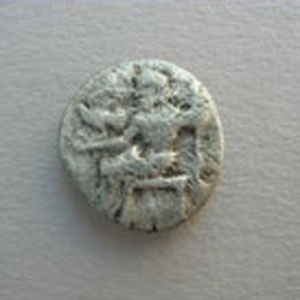Discover the birthplace of Zeus
The Greek god of thunder began in the earth, and scientists thought they finally knew where it came from.
According to a group of American and Greek archaeologists, the ancient Greeks first worshiped the powerful Zeus at a shrine on Mount Lykaion. During a recent excavation at the site, the researchers discovered ritual items commonly used in worship and dating back over 3 millennia. This is the earliest evidence of the appearance of Zeus in Greece.
This discovery challenges the notion that the worship of Zeus began on the Greek island of Crete, where at least one ancient historian named god's mythological birthplace . The latest findings on Mount Lykaion in Arcadia province are as old as the concept of Zeus itself, according to scientist David Romano of the University of Pennsylvania.
Romano said: 'This new evidence shows that there are parties that took place on the summit about 3,300 to 3,400 years ago.'
The worship of thunder gods is still intact
Zeus is the most important figure in ancient Greek mythology. He is the supreme ruler of Mount Olympus, the god of the sky and the father of other gods and people, such as Athena, Apollo, Heracles, Aphrodite and Helen of Troy, according to legend.
This hero is born either on Crete or on Mount Lykaion, according to two sources written in ancient times. While legend is like that, historians and archaeologists are always interested in finding the elements in the story at least based on the truth.
 The left side of the silver coin, Zeus Lykaios sat on the throne with the eagle parked on his left hand. Silver coins have a diameter of 2 cm, dating back to the 5th century BC. (Photo: Image courtesy of University of Pennsylvania Museum)
The left side of the silver coin, Zeus Lykaios sat on the throne with the eagle parked on his left hand. Silver coins have a diameter of 2 cm, dating back to the 5th century BC. (Photo: Image courtesy of University of Pennsylvania Museum)
Although the temple of Zeus, which has one of the seven wonders of the ancient world, is found throughout Greece.The birthplace of Zeus may be the place where the Greeks first worshiped him.
When excavating a cellar on Lykaion Mountain, where ancient Greek historians later called 'Zeus' ashes, archaeologists discovered over 50 water containers, parts of human and animal statues, along with burnt bones of goats and sheep. All of these artifacts match the Mycenae worship rituals settled in Greece approximately 3,000 to 4,000 years ago.
Part of these items was preliminarily announced by the team last year.
The Mycenae mountain peaks are rare in Greece's main territory, according to archaeologists. This period also coincides with the first historical mention of Zeus in Greek pages . This shows that the rituals on Mount Lykaion are to honor him.
The custom of worshiping Zeus has become more popular on Mount Lykaion in ancient Greece, according to the research team including archaeologists from the University of Pennsylvania, Arizona and the Greek Archaeological Service.
The newer and taller cellars have silver coins, a bronze brass arm holding a bunch of thunder; Past excavations were also about stone lightning. All of these objects carry an affirmation of Zeus, which shows that the use of the god worship projects on Mount Lykaion remains unchanged for several millennia.
Myths and history
The relationship between myth and history does not seem to apply alone in the case of ancient Greece. Many ancient cultures also adore times with relationships both in the physical and spiritual world.
 The image of Zeus's chariot from the 'Greek tragedies' in 1879 by Afred Church
The image of Zeus's chariot from the 'Greek tragedies' in 1879 by Afred Church
Places in reality mentioned in mythical scriptures often become places of worship or temples such as Mount Lykaion and vice versa. This is especially true for divine birth places or houses, such as:
Heliopolis, Egypt: Although destroyed and swallowed up largely by the expansion of modern Cairo, the ancient city of Heliopolis was once the center of the worship of Ra of Egypt, this is the dark Sun god. high. Coming out in the evening and being reborn every morning, according to legend, he lay on a boat floating all night in hell.
Kilauea, Hawaii: The sacred volcano on the Big Island of Hawaii is both frightening (because it is the most active volcano on the planet) and revered because it is the home of Pele, the Fire God of Hawaii. Tourists who disrespect Kilauea or take stones from the mountain will make Pele god angry and will curse the ill-fated people.
Teotihuacan, Mexico: The most important place of Aztecs before Colombia and the main city of the world, Teotihuacan is also the center of worship of the feathered snake god Quetzalcoatl, the founder of Aztec. Aztec mythology tells that at the temple on this place, the god Quetzalcoatl first had feathers attached to his snake-like body.
- Interesting truth about Zeus in Greek mythology
- New discovery about the birthplace of Buddha
- Found the birthplace of the Roman emperor Augustus
- The tallest dog on the planet
- Lumbini, the birthplace of Shakyamuni Buddha
- Things you probably don't know about Greece
- Discover the 'birthplace' of modern people
- Compare 7 world wonders in ancient and modern times
- Silicon Valley 'revived from the ashes'
- The smallest plane in the world returned ... origin
- Kraken monster is real?
- 7 Wondering what the world once collapsed will look like if it survives to this day?
 Discovered an ancient centipede fossil 99 million years old
Discovered an ancient centipede fossil 99 million years old Discovered bat-like dinosaurs in China
Discovered bat-like dinosaurs in China Discovered a 200-year-old bronze cannon of the coast
Discovered a 200-year-old bronze cannon of the coast Discover 305 million-year-old spider fossils
Discover 305 million-year-old spider fossils